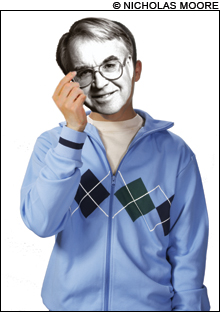
FOLLOWING THE MAESTRO What leads an otherwise normal, red-blooded high-school student to take up the path of former Fed chairman Alan Greenspan? Nothing better to do. |
A version of this article first appeared in issue 19 of The Baffler.
I can't say I ever intended from a young age to spend my 18th year mastering Washington Consensus–era monetary policy to recite in stuttering, rote cliché before a panel of mildly curious economic policymakers who filled out the payroll at Alan Greenspan's Randian fiefdom.I didn't play football, or soccer, or any of the other exhausting things; my fourth-grade rendition of "Hot Cross Buns" on the recorder didn't give way to more ambitious musical pursuits; and the school newspaper already had a core stable of scribes to file the biweekly "Christina Aguilera vs. Britney Spears: Who's Hotter?" trend pieces and listicles. What top-tier private university would continue reading a student's application after noting that he'd failed to deliver such scholastic contribution? So let's settle on the market-friendly explanation: I was incentivized to take a spot on my high school's Federal Reserve competition team that senior year, for lack of much else to do.
And somehow, over a few months, I became fluent in the tongue of historically resolved, tightly synthesized neoclassical bullshit.
The United States was insulated from any fundamental economic problems, the think-tank consensus maintained during my 2002–2003 school year, but my generation would still be charged with resolving one or two pesky loose ends. In 10 or 20 years, once the Treasury had funneled enough of its ever-expanding annual surpluses into paying off the country's entire public debt, who would stop it from malinvesting excess funds into private markets and causing "distortions"? Who would liberate the oppressed Social Security surplus from its lifelong imprisonment in low-yielding Treasury bills, sending it safely into the cozy trenches of speculative finance? Who would marry the next wave of Andrea Mitchells, play Sunday footsies with the unworthy heirs to Tim Russert, and Irish the Bethesda dinner-party coffees of future George Wills as they retrofitted Fed anecdotes from the House of Plantagenet to shed light on current transportation policy?
Why, the Fed Challenge kids would.
And so that's why I became a teenage supplicant at the enormous, glossy table that dominates the boardroom of the Federal Reserve one muggy Washington afternoon in April 2003. Depending on how you remember it, this was either a few days before our president announced the successful resolution of hostilities in Iraq, or a few days after you and your neighbors took out your first second mortgages.
Until recently, I'd never watched tapes of the competition or bothered to look back at how well our presentation — crafted explicitly upon what various personalities at the Fed were saying at the time — held up. I can say now that we were accurately depicting what policymakers, ranging all the way from center-left to center-right, were saying. Had my long-term planning that year not been exclusively devoted to persuading one particular sophomore girl to date me, I might have noticed that the Fed was grooming types like me to carry the torch of efficient, market-allocated human welfare into the second generation of the Great Moderation, fully untethered from the stubborn demands of history and the clutches of modest inflation.